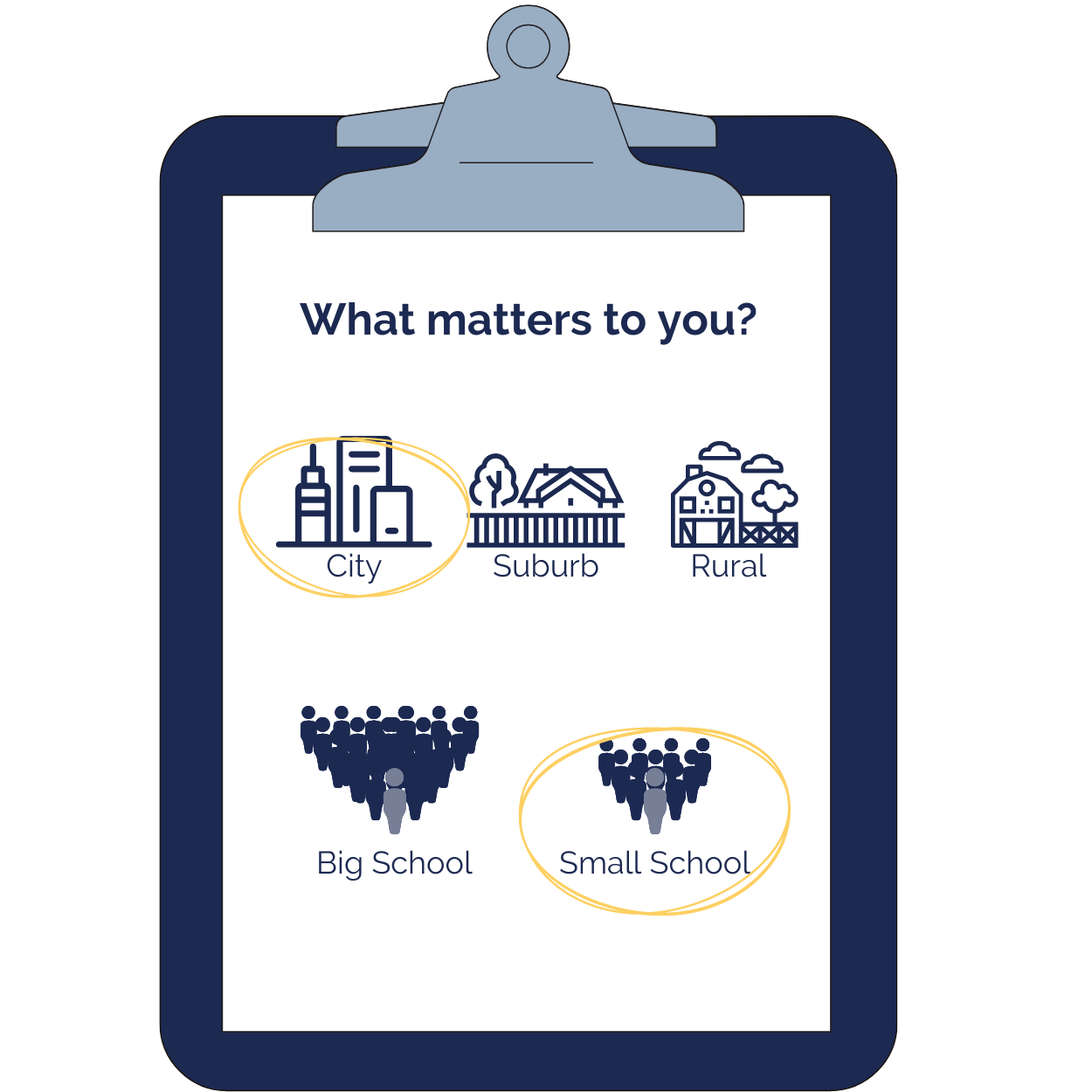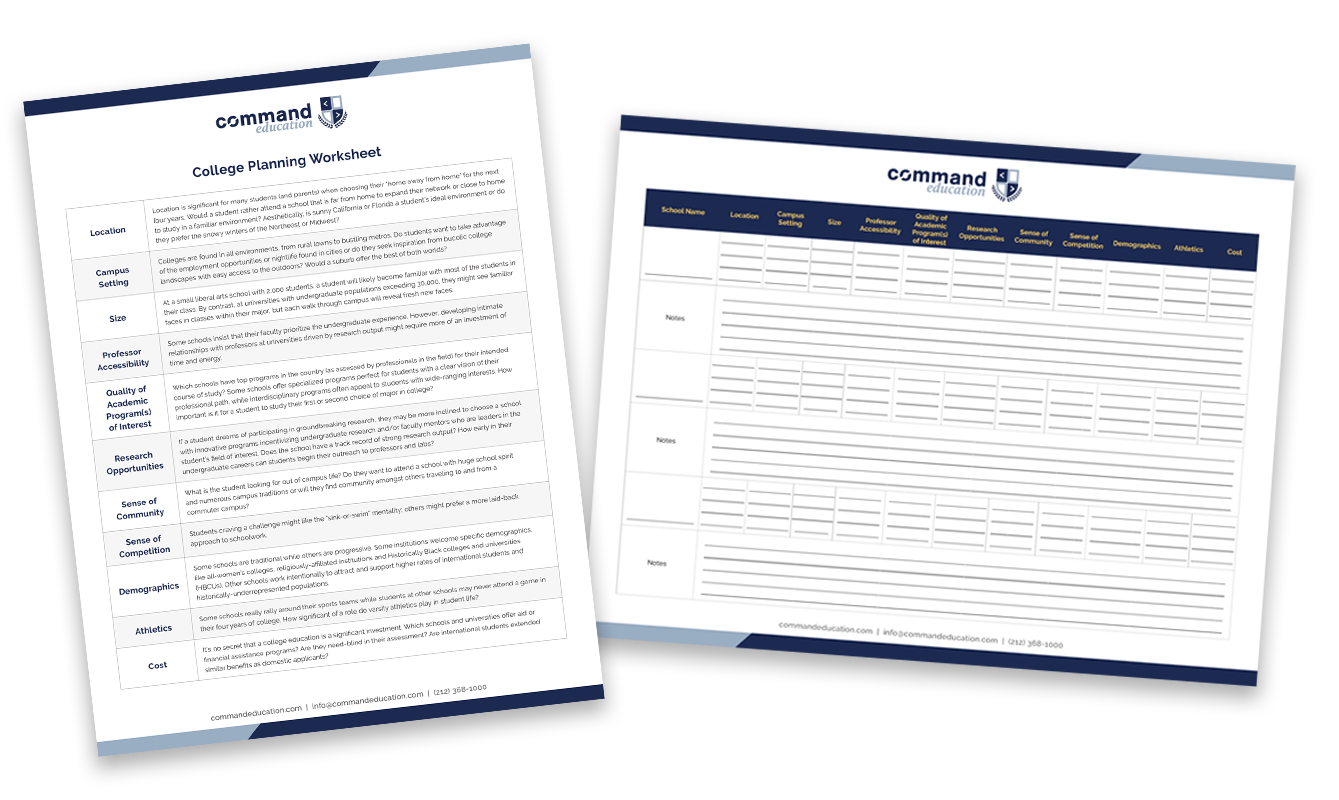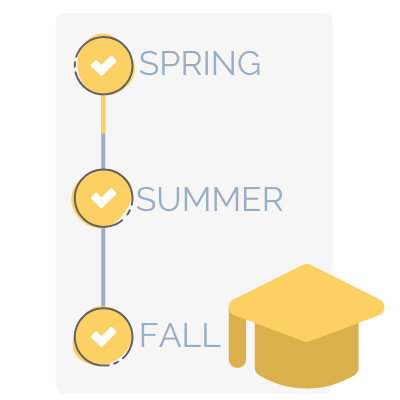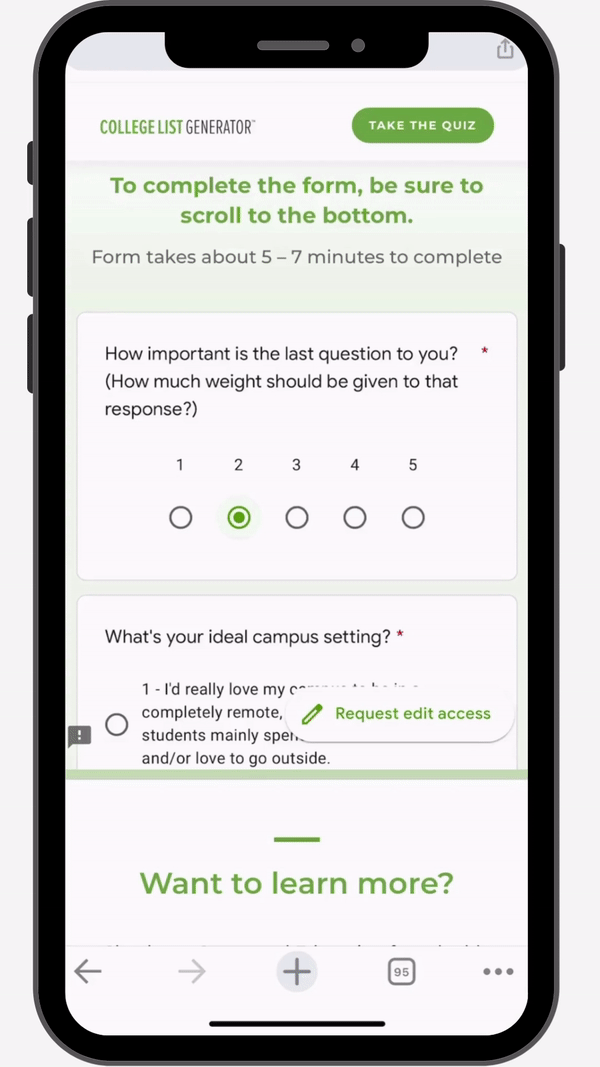Creating a college list can be a daunting process as there are thousands of universities to choose from—the US alone is home to over 5,000 undergraduate programs! If you’re just starting the college process, you might be tempted to apply to the top 25 ranked colleges or to the most popular universities that peers from your school tend to apply to and call it a day. What most students don’t realize when they begin their research, however, is that each school offers vastly different opportunities that may or may not best suit a student’s interests, goals and personality!
If you find yourself at a loss for how to get started, read on. Command Education has some helpful tips to set you up for success throughout the research and college list creation process.
Where do you even begin? The answer is… with yourself! To know where to look, you first have to know what you are looking for in a university, and determining what you want out of your college experience requires understanding your personal, academic, and social preferences. As such, you must reflect on your past experiences to determine what you would like for your future.
For many students, the college admissions process presents a first opportunity to meaningfully reflect on how they want to use their education in the future. The more introspective and honest you are with yourself, the more your college list will reflect your priorities as a student and member of your future college community.
Let’s begin by discussing some of the commonly asked questions about college lists.
What is a balanced college list?
When we say “balanced” at Command Education, we mean a college list that has a strategic distribution of reaches, matches, and safeties that meet your criteria and needs. What are reach, match and safety schools, you ask?
High Reach
A ‘high reach’ school is one where impressive students with perfect scores and impressive accomplishments are routinely rejected. Ivy League institutions and other top schools like Stanford, MIT, Duke, and UChicago are “high reaches” for any applicant, even Nobel Prize winners and Olympians.
Reach
A reach school is one where your academic credentials are near or below the standard profile of accepted students and/or the school has incredibly low acceptance rates (20-25% or less).
Match
A match school is one where your scores fall around the average (or above average) of the school’s accepted students, so you will hopefully be admitted to at least a couple of your match schools.
Safety
A safety school is one where your grades and test scores are well above the school’s 75th percentile for accepted students, so it is “safe” to assume that you would be admitted.
One person’s match could be another person’s reach. It is important to be honest with yourself when putting schools into each of these categories!
How many schools should I apply to?
We recommend that you apply to about 10 to 15 schools, but no more than 20. Within that range, you should apply to:
4-6 Reach Schools
4-6 Match Schools
2-3 Safety Schools
…give or take a few in each category. Applying to too many reaches could leave you with few choices come spring, and applying to too many matches and safeties could prevent you from maximizing your potential. A well-balanced college list provides a safety net but affords you the opportunity to take some risks.
Creating a College List
Choosing the Factors That are Most Important to You
Now that you know how to structure your list, your initial stab at filling that list with schools requires that you become familiar with the criteria that differentiate universities and assess which of those factors are most important to you. Thus, starting the research process begins with answering questions about your personal preferences and values.
What academic subjects have you enjoyed the most in high school? With what kinds of individuals do you seek friendships? In what kinds of social environments do you feel most comfortable? What is your definition of success? What activities make you lose track of time? Do you want to live in a city, a suburb, or a rural area? Do you want to attend a women’s college? Would you prefer to attend a small school or a big school? Would you prefer to be on the East or West Coast? How about the South or the Midwest?

While these questions seem broad, answering them honestly will help you begin to narrow down what to look for when learning about colleges. Below, we’ve compiled a list of essential factors to consider when choosing which colleges to include in your list.
College Planning Worksheet
Here is a list of essential factors for you to consider as you work to create your college list. This list encompasses the factors that are typically considered most important and will play an essential role in helping you to narrow down your list!
You may have an obvious preference concerning some of the factors. For example, you may attend a very small high school and know you want to attend a college or university double its size. However, you may look at one or two of the factors and wonder ‘how do I know if that’s important to me?’ or ‘how do I know if I prefer one criteria over another?’ This may occur if you’ve never had to consider the impact of one or two factors on your lived experience. The best way to determine the answers to such questions is to be thorough in your research!

Download the FREE College Planning Worksheet

Download the FREE College Planning Worksheet
How to Use this Worksheet:
1. Students and parent(s) should begin by taking the time to understand and discuss the factors listed below using the descriptions next to each category. Visiting schools and attending information sessions, either virtually or in person, can help students and parents gain a solid understanding of how these factors can inform one’s college experience.
2. Once you understand each factor, take some time to jot down a few reasons why each factor is more or less important to you, ranking each factor on the list in order of importance. We recommend that parents and students each complete this worksheet on their own and then sit down together to discuss their assessment of each of the various factors’ importance.
Now, it’s time to see which of the 5,000+ options could be a good fit based on the factors you just considered.
“Need to Have” versus “Nice to Have” Factors
You should begin by listing schools that satisfy the one or two factors from the worksheet you deem to be the most important. We call these factors the “need to have” factors, or those qualities or resources that are non-negotiable for you. On the other hand, your “nice to have” factors are those which would definitely increase your interest in a school; however, their presence or absence will not necessarily prevent you from attending a particular school.
For some students, “need to have” factors include the school’s geographic location or top ranking in a particular academic field. Other students may choose to prioritize research, pre-professional opportunities, or the presence of a particular sports team on campus. Say you know you want to be in the New England and Mid-Atlantic regions of the US — you may create a preliminary (and admittedly quite lengthy) list of schools located in those states. Then, you might narrow your college list by removing some of the schools that do not satisfy ‘nice to have’ preferences.
Need to Have
East Coast or Mid-Atlantic region
Competitive campus climate
Nice to Have
Urban campus setting
Strong research opportunities
Big sports program
Lots of campus traditions
Use our College List Creator Tool
Once you’ve differentiated your “need to have” factors from your “nice to haves,” take note of which schools appear to satisfy the majority of your criteria. There are plenty of search engines or databases you can use to research colleges by specific factors, such as US News and World Report, Niche, or Forbes. Alternatively, to save time, you can check out Command Education’s College List Generator, which aggregates all of these important criteria, allows you to indicate your preferences and the corresponding level of importance each factor has for you, and outputs an initial list for starting your search.
It may be the case that your priorities and preferences shift over time as you learn more about schools’ differing offerings and as you learn and grow as an individual (which makes sense!). For this reason, it’s important to be patient and flexible in your thinking as you do the initial work of determining what your “need to have” and “nice to have” factors are.
KEY TIP
Make sure to check-in with yourself throughout the research process about whether or not your answers to the questions have shifted!
Be open to the possibility that you might love attending a school at which you didn’t initially imagine yourself thriving! Although you may feel like there’s only one school that offers a perfect fit, it’s very possible that you would feel happy and comfortable in two very different types of schools.
How to Research Colleges and Universities
Once you have an initial list of schools to research, you can begin researching each school on your list in more depth, with the aim of both narrowing down your initial list and potentially discovering additional factors that can help you identify more schools for your list.
Research using college and university websites
You can start your research by visiting colleges’ websites to learn about their specific application process and to get a feel for what a school might offer. College websites are a treasure trove of information — you should start by reading a college’s mission statement, as this will allow you to learn about the school’s foundational values and determine whether they seem to match your own.
If you have an area of academic focus or specific major in mind, research class descriptions, professors’ bios, or the major and minor requirements on department websites. Here, you may also find information about specific study abroad and research programs, as well as other opportunities you could take advantage of as a student.
Further, these school’s department pages may offer insights into the specific pedagogy employed by that university. While colleges often offer similar majors, your experience studying at each school is likely to differ depending on the specific department’s focus. For instance, UC Berkeley offers a more progressive and contemporary take on literature than Columbia, whose English department is more grounded in a classical canon. Additionally, Harvard’s computer science department takes more of a theoretical approach compared to Stanford’s core requirements, which require more applied learning. The University of Chicago’s economics department hosts more intellectual leaders who follow conservative theories of the market than Yale’s.
Watch videos on Youtube or CampusReel to see what current students are up to on campus
Now that you’ve learned about a college’s academic offerings, you should spend some time learning about its extracurricular opportunities and campus life! A great way to do this is to watch videos published by current or former students on YouTube or CampusReel. Some students will take you on tours of their dorm rooms or talk about what the typical day in the life of a student looks like at their college, offering you the ability to learn from a peer about what it’s like to attend their school!
Visit campus
The best way to get a feel for a college campus is to see it yourself! Walking around campus will give you a sense of student life on campus and hopefully a taste of how the college’s culture will impact your studies during your four years. Check out dorms, dining halls, fitness centers, libraries, and other campus facilities to ensure the environment could one day feel like home for you. Don’t be afraid to go up to current students and ask about life outside of the classroom. Sign up for official campus tours and information sessions to learn about the college and connect with admissions officers.
While we recommend visiting most of the schools on your final list, we recognize that can be time-consuming and expensive. Definitely try your best to visit the schools to which you plan to apply early, especially if you are applying under a binding Early Decision program. Beyond that, any additional visits you can manage to your favorite reaches and matches will help inform your understanding of your potential postsecondary options.
Visits are important, not only for gaining insight into the schools you are considering but also for demonstrating interest, which (depending on whether your schools track demonstrated interest) can matter to the admissions counselors considering your application. We recommend visiting at some point during your junior year, either during a long weekend during the fall semester or during the summer when you have more free time.
Engage in colleges' virtual tour or information sessions
If you’re unable to visit a college in person, you can take advantage of virtual tours to experience campus remotely. Most colleges will supplement virtual tours with virtual information sessions, so definitely sign up for both, as that can allow you to demonstrate your interest even from afar! If the live virtual information sessions don’t work with your schedule, some schools offer pre-recorded information sessions on their admissions website or YouTube channel.
KEY TIP
During the sessions, take note of your likes and dislikes for each school. It can be difficult to remember small details six months after your visit when you sit down to write your college applications, many of which will ask you to describe the specific aspects of the school that have caught your interest. Taking specific notes throughout the research process will prepare you to nail those types of supplemental essays!
Whether virtual or in-person, we highly recommend attending these sessions as a way to learn more about each school. These sessions also offer a great opportunity for you to have your questions answered, as most end with a question-and-answer period.
Have a coffee chat with an alumnus
Another great way to learn about a college is to chat with an alum to learn more about their experiences! You can check out your high school’s alumni network to see if any former students from your high school have attended the schools you’re considering, or you can email current students to ask if they’d be willing to chat about the college. You might also gain a valuable mentor along the way!
Discuss your list with College counselors
Finally, the college counselors at your school can serve as another great resource for gaining an additional perspective on which schools are reach, match, or safety options for you. For example, you could ask, “How have past students with my profile fared in the application process to (insert school name)?” Using aggregated historical data, your guidance counselor can answer these questions anonymously, giving you a better sense of how your school and its alumni have performed in the college application process.
Case Studies
We know this is a lot of information to take in, but rest assured that like all long-term projects, building your college list is a process that will inevitably evolve over time. Every student will have unique considerations specific to their profile and preferences. Therefore, what’s important is that you take the time to reflect on your past experience and future goals to ensure that the schools on your college list are consistent with your vision for your experience and beyond. Below we have put together two hypothetical student profiles—Student A and Student B—to illustrate how different students’ college lists can look.

Student A
Stats: GPA = 3.6; SAT = 1350
Extracurriculars: Tennis, Robotics, VR Lab Intern
Personality:
- Works best when close to his teacher/classmates
- Watches any sporting event he can find on TV
Reach
Williams College
Middlebury College
Davidson College
University of Notre Dame
Boston College
Match
Wake Forest University
Santa Clara University
Colgate University
Bucknell University
Virginia Tech
Safety
Hobart and William Smith Colleges
Wofford College
Student A’s College List Explained
Student A has a wealth of experience in the field of engineering, both through his school’s robotics club and a virtual reality summer internship. His statistical profile might limit his odds of gaining admission to the most competitive research universities, but he’s still within the range of many great schools. As a student, he’s learned that he thrives in small learning environments in which he’s able to develop meaningful relationships with his teachers and peers. Further, he’s a huge sports fan who hopes to spend many weekends in college cheering on his school’s sports teams.
For Student A, the College List Generator populated a unique array of schools that fulfill his desire to pursue engineering in an intimate campus community in which he thrives best. Schools like Virginia Tech, Notre Dame, and Bucknell have top engineering programs that can expand Student A’s horizons in the field while the smaller liberal arts colleges like Williams, Middlebury, Davidson, and Colgate offer unique 3-2 exchange programs through which students can spend two years studying at renowned engineering programs at Columbia, Dartmouth, RPI, or WashU. Further, since Student A indicated a strong interest in sports, most of the schools on his college list are institutions with competitive track records in athletics, including D1 football (Notre Dame, Virginia Tech, Boston College, Wake Forest), D1 basketball (Davidson, Colgate, Bucknell, Wofford), or D3 sports in general (Williams, Middlebury, Hobart).

Student B
Stats: GPA = 3.9, SAT = 1570
Extracurriculars: Girl Scout, Hospital Volunteer
Personality:
- Self-motivated, independent, seeks intellectual challenges
- Career-oriented, wants hospital work experience ASAP
Reach
University of Pennsylvania
Johns Hopkins University
Harvard University
Cornell University
Carnegie Mellon University
Match
Case Western Reserve University
George Washington University
University of California, San Diego
University of Michigan
Smith College
Safety
University of California, Irvine
Spelman College
Student B’s College List Explained
Student B has had lifelong aspirations of becoming a doctor, seeking any opportunity to be in a hospital or demonstrate her leadership capabilities. She has achieved top scores in the classroom and on standardized tests, which will allow her to be a competitive applicant to most colleges on her college list. Student B does not shy away from a challenge and is always determined to find a solution that she can work towards by hitting the books in the library or signing up for instructional webinars that can inform her career endeavors.
Sensing Student B’s independence and attraction towards the most competitive academic environments, the College List Generator’s results feature schools boasting top pre-med programs, including Harvard, Johns Hopkins, and Smith. Additionally, both Case Western and George Washington offer accelerated Bachelor/MD programs, which could expedite her progress towards achieving a medical degree on a shorter timeline.
Additional Resources
We hope that this resource provides you with helpful information about how to get started on this exciting endeavor! More than anything else, researching universities and assembling your list is a chance to get to know yourself better. College is a huge investment of time and money, so spending considerable time evaluating your past, present, and future is a responsible way to ensure that your prospective college options match your values and ambitions. People in your life, such as family, friends, college counselors or other mentors, can also help you manage those feelings of stress and provide you with further insight. Regardless of how you go about it, we hope that putting together your college list will be an enlightening and meaningful experience. Good luck!
Below are some additional resources for you to check out as you create your balanced college list!

Compare Best-Fit Colleges
The Schools Hub

College List Generator
Generate a List of Best-Fit Colleges






